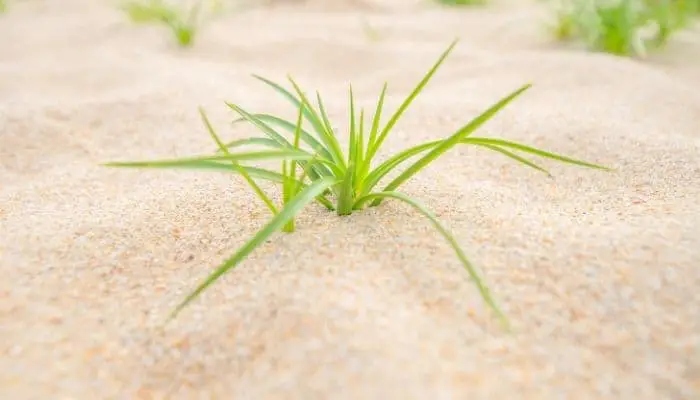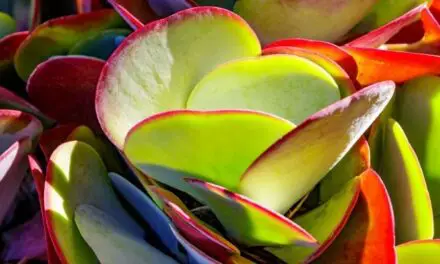You’ll find various types of grass growing on every continent on earth and in a wide range of habitats.
There’s no doubt that grass is tough.
It can withstand wind, endure drought, and grow in places where other plants would have no hope.
But will grass also grow in sand?
Table of Contents
Will Grass Grow In Sand?

Grass will have a difficult time growing in pure sand because it has too many rock-based particles and not enough organic particles to provide the nutrients grass needs to grow.
Pure sand is also not firm enough to give the roots of grass a secure footing and may not hold on to water long enough for the grass roots to absorb enough moisture to survive.
However, grass can grow very well in sandy soil or sand that has been improved with organic material, as long as it gets water, sunlight, and nutrients.
Grass can be found thriving in many sandy environments but it is unlikely to last for long in pure sand with zero cult, clay, or organic particles.
Also Read: Why Do Plants Need Soil to Grow?
What Does Grass Need To Grow?
Grass is a relatively simple plant to grow.
In fact, some species of grass grow so easily that they often pop up where they are not wanted (like on the lawns we work hard to keep up!) and are considered weeds.
Nevertheless, like all plants, grass needs certain conditions to germinate, grow, and thrive.
To survive, grass needs the following:
- Sunlight.
- Water.
- Soil.
- Nutrients.
Sunlight
Sunlight is the easy part.
It’s free, it’s everywhere, and as long as grass gets just a few hours of light a day, it will do fine.
Water
Water for grass can come from rain, irrigation, or other human sources.
But it’s important that there be enough water present in the soil long enough to be absorbed by the roots of the grass.
This is one of the important functions of soil – the retention of water.
When water, for example, is poured into the soil of a potted plant the majority of the water volume stays in the soil.
If the water was instead poured into a pile of loose stones, it would pass right through.
Good soil holds water well.
Soil And Nutrients
Grass also needs to come into contact with external nutrients, either through the water or the soil.
Although many nutrients are initially present in some natural soils, once they are absorbed by the plant they must be added back to the soil again through fertilization.
Nitrogen, for instance, is one of the most important nutrients for plants and is abundant in certain rich soils.
Grass grows best in a soil base that has some nutrient content and can retain water.
So, how does sand fit into the picture?
What Is Sand And What Is In It?
Sand is a broad term for any fine-grained material of rock and minerals.
Most typically found in deserts and on beaches, there is a wide variation in different types of sand.
Desert sand is mostly made of a silicon material, like fine-grained quartz, where beach sand, especially in the tropics, typically consists of tiny pieces of shells and coral.
Some other sands contain volcanic rock.
None of these sands contain the nutrients needed for the thriving of grass like the standard “dirt” or clay that we normally associate with soil.
When we see tall grass in beach dunes, they’re growing “through” the beach sand from the soil beneath.
Also, desert plants like cacti have adapted to grow with little available water.
Sand can support grass, though, when used in conjunction with other types of soil.
Can Grass Grow In Sandy Soil
Sand is often mixed with other types of soil, like clay-based soil.
If the largest portion of the mixture is sand, it is considered “sandy soil”.
Although sand itself does not have the nutrient or water-retention properties to make the best basis for grass by itself, sandy soil is known to support a variety of plants, including many types of grass.
The soil in tropical regions like Florida and the Caribbean is notoriously sandy and can support lush grass lawns and landscapes.
Final Thoughts
Putting all of these facts together, we see that grass can indeed grow in the sand as long as it contains some degree of organic matter.
Whether grass will grow in sand depends on a few factors.
Since pure sand alone cannot provide grass with the nutrients it needs, the nutrients must come from another source.
That source can be from the addition of fertilizer, or from a more nutrient-rich soil mixed with the sand in sufficient proportion.
Pure sand is essentially made of tiny rocks and thus does a poor job of retaining water.
Although some types of sand could physically support the root system of grass, it’s unlikely to hold water in place long enough for the roots to absorb what they need.
This means that frequent watering would be needed to keep up.
So, again, the addition of a more absorptive soil will help sand be a much better host to grass.
In short, sandy soil with sufficient nutrients and water can certainly support the growth of grass, but pure sand is unlikely to be up to the task.




